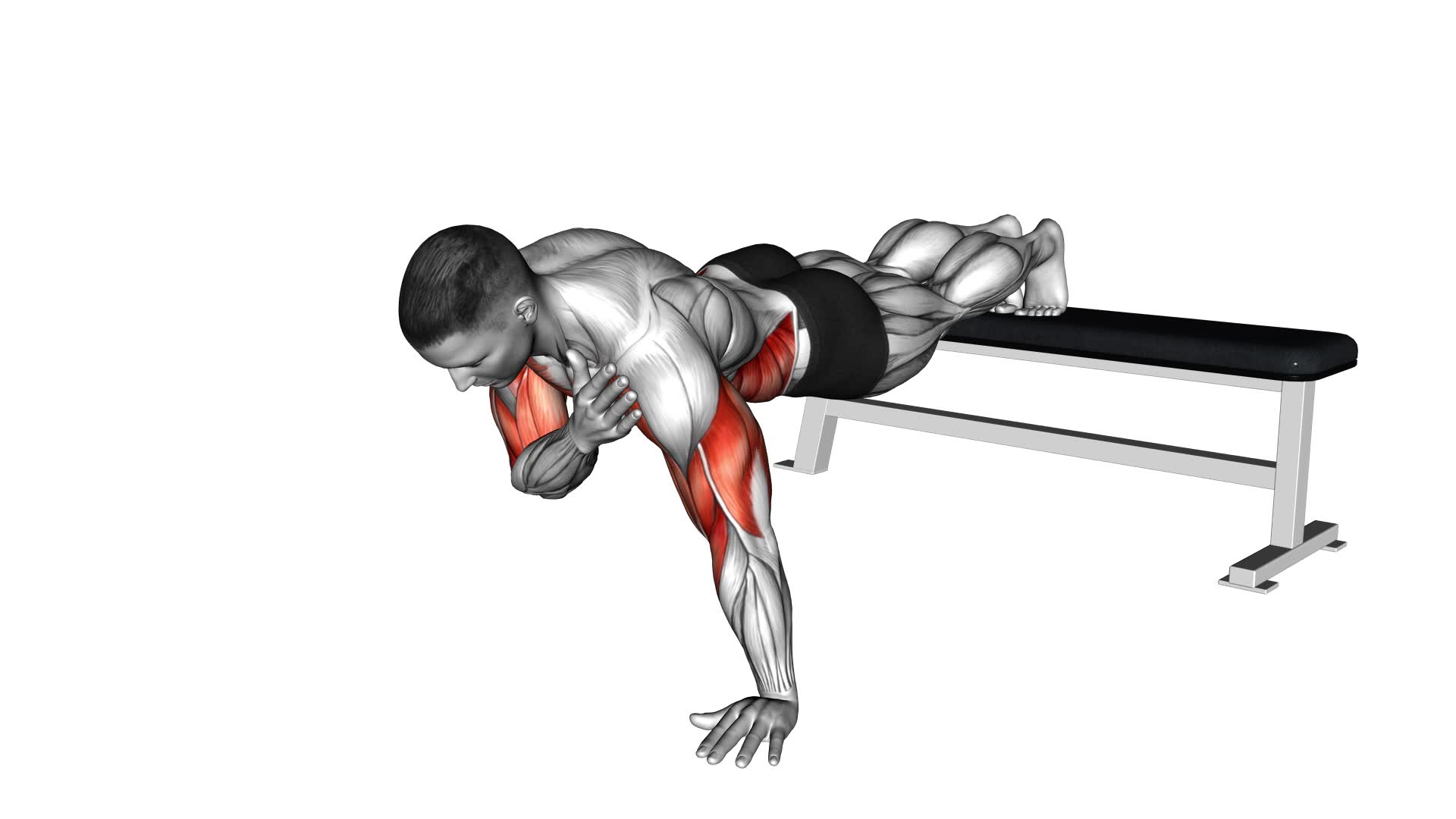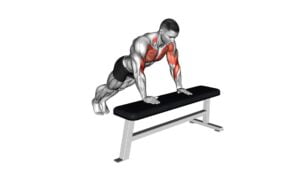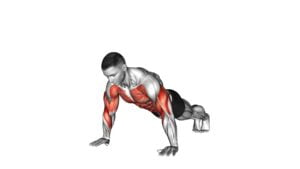Decline Shoulder Tap – Video Exercise Guide & Tips

Looking to strengthen and stabilize your shoulders? Look no further than the decline shoulder tap exercise.
Watch This Exercise Video
In this video exercise guide, we'll walk you through the proper form and technique, as well as provide modifications for different fitness levels.
Avoid common mistakes and maximize your shoulder strength with our expert tips.
Get ready to take your shoulder workouts to the next level with the decline shoulder tap.
Key Takeaways
- Increased core stability and shoulder strength
- Engage core and shoulder muscles for strength and stability
- Maintain proper form and technique to avoid injury
- Modify the exercise for different fitness levels
Benefits of Decline Shoulder Tap
You will experience increased core stability and shoulder strength with the Decline Shoulder Tap exercise. This exercise offers various progression variations for you to challenge yourself as you get stronger.
By starting with a basic decline shoulder tap, where you place your hands on an elevated surface and tap each shoulder alternately, you can gradually increase the difficulty by using a higher surface or adding a stability ball under your feet. These progressions engage your core and shoulder muscles even more, helping you build strength and stability.
However, it's important to take precautions and use injury prevention techniques when performing the decline shoulder tap. Make sure to maintain proper form throughout the exercise, keeping your core engaged and your body in a straight line. Avoid any excessive arching or sagging of the lower back, as this can put strain on your spine. Additionally, listen to your body and start with a lower level of difficulty if you're a beginner or have any existing shoulder or core issues.
Now that you understand the benefits, progressions, and precautions of the decline shoulder tap, let's move on to discussing proper form and technique in the next section.
Proper Form and Technique
To ensure proper form and technique during the decline shoulder tap exercise, it's crucial to maintain a straight line with your body and engage your core muscles throughout the movement. This not only helps to prevent injuries but also allows for effective progression strategies.
Maintaining a straight line with your body means keeping your head, shoulders, hips, and feet aligned. This helps to distribute the load evenly and minimizes the risk of straining any particular muscle group. Engaging your core muscles, especially your abdominals, is essential for stability and control during the exercise. It allows you to maintain a strong and stable position, reducing the risk of injury.
In addition to proper alignment and core engagement, it's important to focus on controlled movements. Avoid rushing through the exercise and instead, concentrate on tapping your opposite shoulder while keeping your body stable. This will help to activate the muscles in your shoulders and core more effectively.
When it comes to progression strategies, start with mastering the basic form and technique of the decline shoulder tap exercise. Once you can perform the exercise with proper form consistently, you can progress by increasing the number of repetitions or adding weights. However, it's crucial to listen to your body and not push yourself beyond your limits. Gradual progression is key to avoiding injury and maximizing the benefits of the exercise.
Modifications for Different Fitness Levels
To modify the decline shoulder tap exercise for different fitness levels, consider adjusting the difficulty by changing the angle of the decline or modifying the range of motion. Here are some progression options and equipment variations to help you tailor the exercise to your fitness level:
- Adjust the angle of the decline: If you're just starting out or have limited upper body strength, you can begin with a small decline or even perform the exercise on a flat surface. As you get stronger, gradually increase the angle of the decline to challenge your muscles more.
- Modify the range of motion: If you find it difficult to perform the exercise with a full range of motion, you can start by tapping your shoulders with one hand at a time, rather than alternating sides. This will help you build stability and strength before progressing to the full exercise.
- Use equipment variations: To make the exercise more challenging, you can add a weight plate or a sandbag on your back. This will increase the resistance and engage your muscles even more.
- Incorporate instability: If you want to further challenge your core and shoulder stability, you can perform the decline shoulder tap exercise on a stability ball or a Bosu ball. This will require greater control and balance, intensifying the workout.
Common Mistakes to Avoid
When performing the decline shoulder tap exercise, it's crucial to be aware of common mistakes that can hinder your progress and potentially lead to injury. To ensure you're getting the most out of this exercise, it's important to focus on proper technique.
One common mistake is allowing your hips to sag or lift too high during the exercise. This can put unnecessary strain on your lower back and decrease the effectiveness of the workout. To avoid this, engage your core muscles and maintain a straight line from your head to your heels throughout the exercise.
Another mistake to watch out for is performing the shoulder tap too quickly or with improper form. This can lead to instability and increase the risk of injury. Instead, take your time and focus on maintaining control and stability. Keep your body steady as you tap each shoulder, and avoid any jerking or twisting motions.
Lastly, it's important to avoid placing too much weight on your shoulders during the exercise. This can put excessive strain on your shoulder joints and increase the risk of injury. Instead, distribute your weight evenly between your hands and shoulders, and focus on engaging your core muscles to support your body.
Tips for Maximizing Shoulder Strength and Stability
To maximize your shoulder strength and stability, focus on proper form and technique while performing the decline shoulder tap exercise. Here are some tips to help you get the most out of your shoulder exercises and shoulder stability training:
- Start with a proper warm-up: Before diving into any shoulder exercise, it's important to warm up your muscles and joints. Perform some light cardio exercises or dynamic stretches to increase blood flow and prepare your shoulders for the workout.
- Engage your core: A strong core provides a stable base for your shoulders. When performing the decline shoulder tap exercise, engage your core muscles by pulling your belly button towards your spine. This will help maintain proper alignment and prevent excessive strain on your shoulders.
- Maintain proper posture: Throughout the exercise, keep your shoulders down and back, and your chest lifted. Avoid slouching or rounding your shoulders, as this can lead to poor form and potential injury.
- Progress gradually: As you build strength and stability in your shoulders, gradually increase the difficulty of your exercises. Start with lighter weights or modifications, and gradually progress to more challenging variations to continue challenging your muscles.
Frequently Asked Questions
How Often Should I Perform Decline Shoulder Taps in a Week to See Results?
To see results from decline shoulder taps, it's important to perform them regularly. Incorporate shoulder tap variations into your weekly workout routine.
Aim to do decline shoulder taps at least three times a week to start seeing improvements in your upper body strength and stability. Consistency is key when it comes to reaping the benefits of this exercise.
Make sure to maintain proper form and gradually increase the intensity as your strength improves.
Can Decline Shoulder Taps Help Improve My Posture?
Decline shoulder taps can be a great exercise for improving your posture. By engaging your core and stabilizing your shoulders, this exercise helps strengthen the muscles that support proper alignment of your spine.
Posture correction exercises like decline shoulder taps can also help alleviate muscle imbalances and reduce the risk of developing postural issues.
Adding this exercise to your routine can have long-term benefits for your posture and overall body alignment.
Are There Any Specific Breathing Techniques I Should Follow While Performing Decline Shoulder Taps?
When performing decline shoulder taps, it's important to focus on your breathing technique. Proper breathing can help you maintain control and stability throughout the exercise.
Take a deep breath in as you lower your body down and tap your shoulders, and exhale as you push back up to the starting position. This will help engage your core and enhance the effectiveness of the exercise.
Remember to breathe steadily and rhythmically throughout each repetition.
Can Decline Shoulder Taps Be Beneficial for Individuals With Shoulder Injuries or Mobility Issues?
Decline shoulder taps can be beneficial for individuals with shoulder injuries or mobility issues. They can aid in shoulder rehabilitation by strengthening the muscles surrounding the shoulder joint. However, it's important to modify the exercise to suit your specific needs.
You may need to start with a smaller range of motion or use a modified hand position. Always consult with a healthcare professional or a certified trainer for guidance on the best modifications for shoulder taps.
Should I Incorporate Decline Shoulder Taps Into My Warm-Up or Cool-Down Routine?
Incorporating decline shoulder taps into your warm-up or cool-down routine can be a beneficial addition.
These exercises target your shoulder muscles and can help improve stability and mobility.
Including them in your warm-up routine can help activate the muscles and prepare them for the workout ahead.
On the other hand, incorporating decline shoulder taps in your cool-down routine can aid in stretching and releasing tension in the shoulder area, promoting recovery and preventing post-workout soreness.
Conclusion
Incorporating decline shoulder taps into your exercise routine can provide numerous benefits, including improved shoulder strength and stability. By maintaining proper form and technique, and making modifications based on your fitness level, you can maximize the effectiveness of this exercise.
Avoid common mistakes, such as arching your lower back or rushing through the movement. Remember to engage your core and focus on maintaining control throughout the exercise for optimal results.

Author
Years ago, the spark of my life’s passion ignited in my mind the moment I stepped into the local gym for the first time. The inaugural bead of perspiration, the initial endeavor, the very first surge of endorphins, and a sense of pride that washed over me post-workout marked the beginning of my deep-seated interest in strength sports, fitness, and sports nutrition. This very curiosity blossomed rapidly into a profound fascination, propelling me to earn a Master’s degree in Physical Education from the Academy of Physical Education in Krakow, followed by a Sports Manager diploma from the Jagiellonian University. My journey of growth led me to gain more specialized qualifications, such as being a certified personal trainer with a focus on sports dietetics, a lifeguard, and an instructor for wellness and corrective gymnastics. Theoretical knowledge paired seamlessly with practical experience, reinforcing my belief that the transformation of individuals under my guidance was also a reflection of my personal growth. This belief holds true even today. Each day, I strive to push the boundaries and explore new realms. These realms gently elevate me to greater heights. The unique combination of passion for my field and the continuous quest for growth fuels my drive to break new ground.







